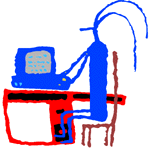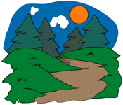Digital
Glyphs: Imaging Ideas for a Visual World
 Use practical, curriculum-connected
activities to teach important visual literacy skills through
the use of scanners, digital cameras, and imaging software.
Use practical, curriculum-connected
activities to teach important visual literacy skills through
the use of scanners, digital cameras, and imaging software.
From ancient rock art to children's sidewalk drawings, we
live in a visual world. Teach important visual literacy
skills through the use of scanners, digital cameras, and
imaging software. Packed with practical projects, explore
a wealth of curriculum-connected activities that incorporate
digital imaging. Explore ideas for KidPix, Photoshop, PowerPoint,
HyperStudio, and other popular software packages. Regardless
of your grade level or content area there are many ways
to enhance learning by connecting pictures and words. Learn More...
 Stuck
in the Mud: Bridging the Knowing-Doing Gap
Stuck
in the Mud: Bridging the Knowing-Doing Gap
Are you spinning your wheels,
but not making much progress with technology integration?
Most educators now have lots of "technology stuff" and know
what they should be doing... but issues such as time, expertise,
access, resources, and support seem to get in the way. There's
a gap between what we know we should do and what we actually
do. It's time to figure out how to most effectively manage
and integrate all the hardware, software, and other resources
available to enhance learning. This article will focus on
strategies for technology leaders that will spark the interests
of your students, teachers, and administrators. Learn More...
 Technology
Landscapes: Adapting to Changing Learning Environments
Technology
Landscapes: Adapting to Changing Learning Environments
Explore the changing landscape
of learning. Regardless of whether you feel like you're
alone in the arctic or with friends at the beach, this article
will help you climb the mountain of success with your technology
projects. Explore the "As" of the classroom technology landscape
including how to apply good practice, adapt current skills,
activate learning environment, address individual differences,
acquire new partners, and advance new ideas. Examine how
Internet can be used as a tool to facilitate learning. Find
out how educators are changing the landscape of teaching
and learning through the use of technology. Survive in unknown
technology territory by applying your knowledge of good
teaching practice, adapting your current skills, and forming
new relationships. Learn More...
 LumberJack
Leadership: School Administrators and Technology Integration
LumberJack
Leadership: School Administrators and Technology Integration
It's not easy being a lumberjack
or a school administrator. With difficult decisions, entrenched
staffs, and changing times, school administrations face
an uphill battle when it comes to technology integration.
For the lumberjack it's not about the cool clothes, the
equipment, or cutting trees. The bottom line is getting
the lumber to market. For educators, the bottom line is
not the technology, but using these resources and tools
to help students access and process information, solve problems,
make decisions, and communicate ideas. Get out your chain
saw and cut through the technology and red tape to get to
the bottom line, learning. Learn More...
 Information
Technology and the Curriculum: Unlock the World of Learning
Information
Technology and the Curriculum: Unlock the World of Learning
Unlocking the world of learning
requires a convergence of technology, information, curriculum,
standards, and assessment.
The key is to set a direction
that assists teachers in connecting curriculum areas with
information technology knowledge and skills. This involves
helping teachers identify where in their teaching students
need to access, process, and communicate information. Then,
providing teachers with the technology resources and tools
they need to build these connections. This article will
help teachers see the link between information technology
and the curriculum. Learn More...
 Catching
the Best of the Web: From Selection to Integration
Catching
the Best of the Web: From Selection to Integration Brick
by Brick: Designing and Developing Teacher Web Pages
Brick
by Brick: Designing and Developing Teacher Web Pages




 Stuck
in the Mud: Bridging the Knowing-Doing Gap
Stuck
in the Mud: Bridging the Knowing-Doing Gap Technology
Landscapes: Adapting to Changing Learning Environments
Technology
Landscapes: Adapting to Changing Learning Environments LumberJack
Leadership: School Administrators and Technology Integration
LumberJack
Leadership: School Administrators and Technology Integration Information
Technology and the Curriculum: Unlock the World of Learning
Information
Technology and the Curriculum: Unlock the World of Learning